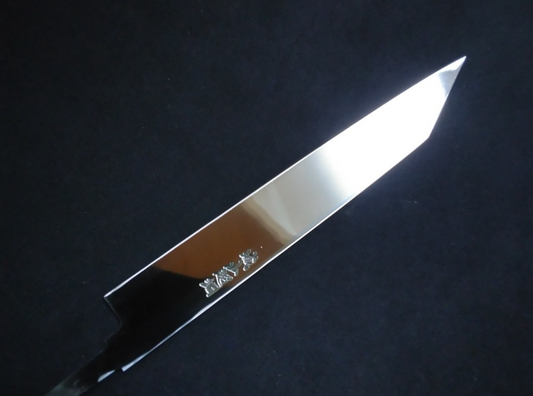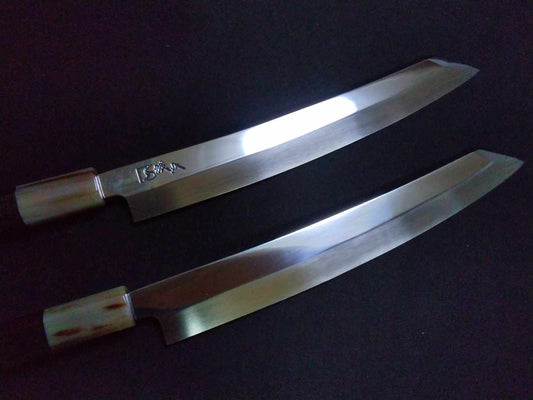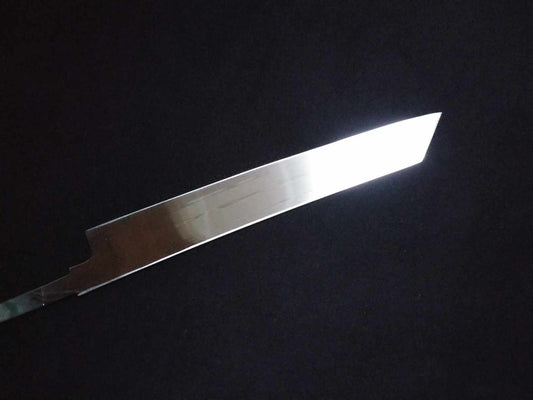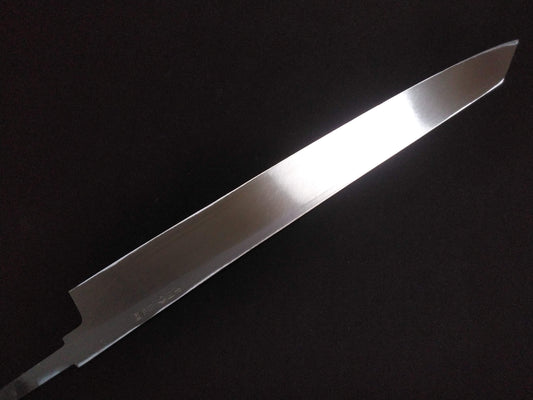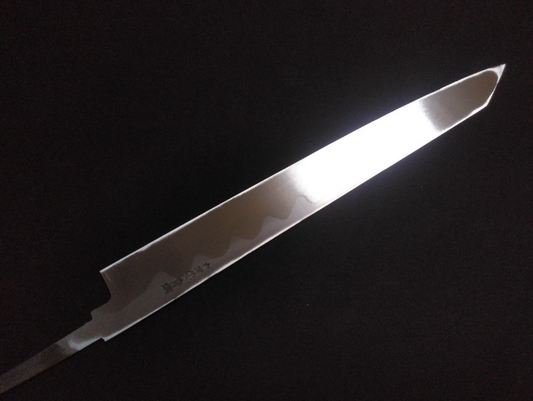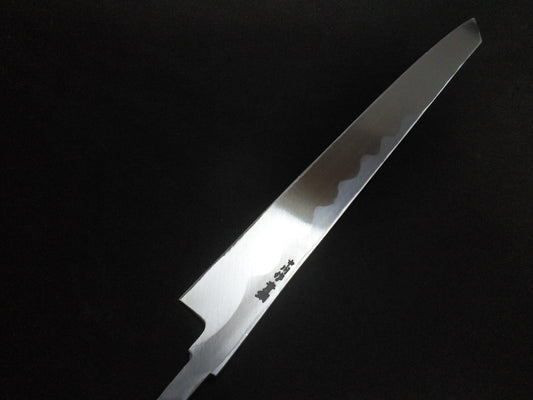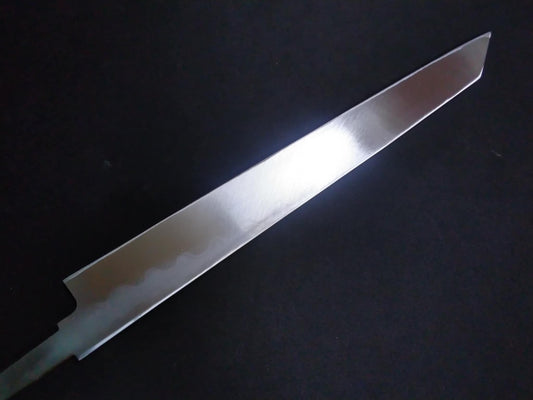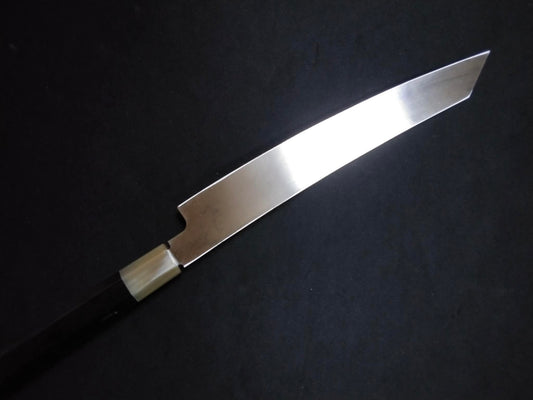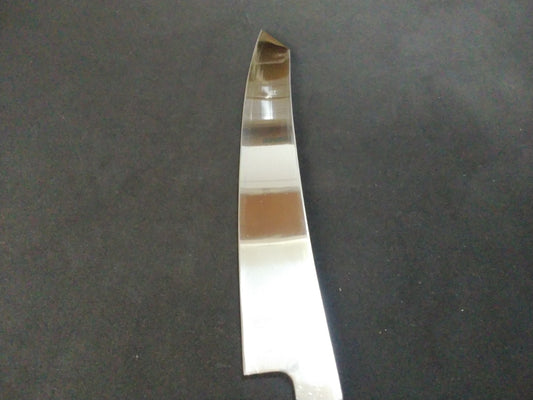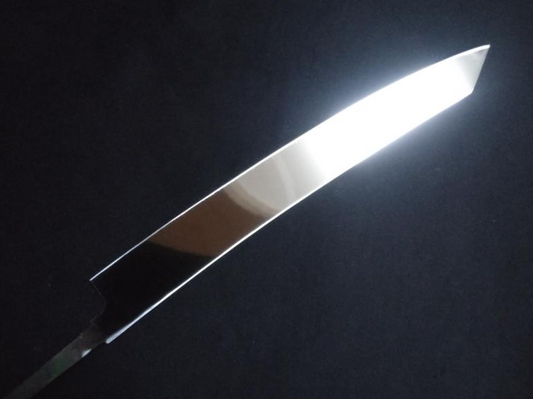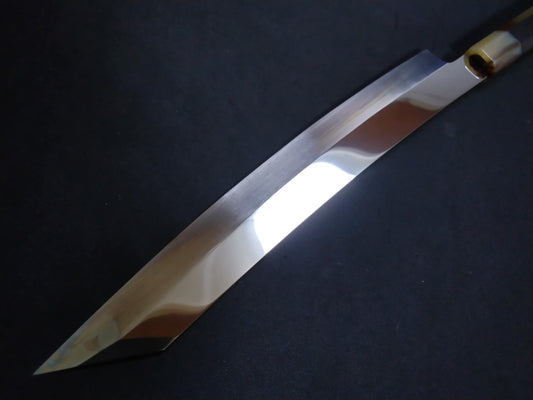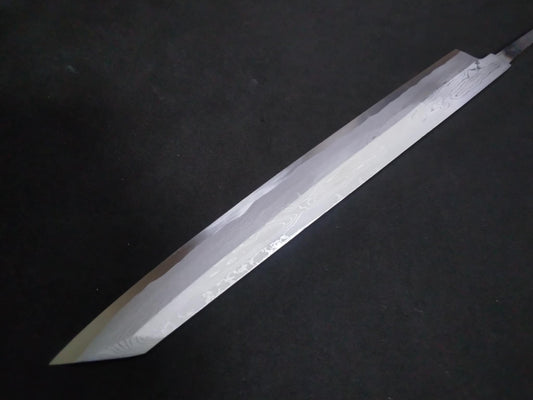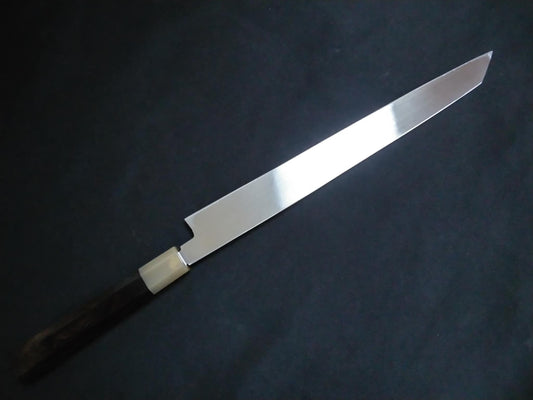
Yanagiba (Kiritsuke)
-
Sleek. Precise. Powerful.
Discover why this modern twist on the traditional sashimi blade is capturing the attention of chefs worldwide. -
Yanagiba(Kiritsuke) Japanese Knife Collection
-
Super Steel (Honyaki) Yanagiba(Kiritsuke) 210mm-Kido Finishing
Regular price $405.00 CADRegular priceUnit price / per$0.00 CADSale price $405.00 CAD -
Ginsan Yanagiba(Kiritsuke) 225mm -Mirror Polished(both sides)
Regular price $412.00 CADRegular priceUnit price / per$0.00 CADSale price $412.00 CADSold out -
Super Steel (Honyaki) Yanagiba(Kiritsuke) 210mm-Mirror Polished(one side)
Regular price $431.00 CADRegular priceUnit price / per$0.00 CADSale price $431.00 CAD -
Super Steel (Honyaki) Yanagiba(Kiritsuke) 210mm-Mirror Polished(both sides)
Regular price $441.00 CADRegular priceUnit price / per$0.00 CADSale price $441.00 CAD -
Super Steel (Honyaki) Yanagiba(Kiritsuke) 210mm-Mirror Polished(both sides)
Regular price $469.00 CADRegular priceUnit price / per$0.00 CADSale price $469.00 CADSold out -
White Steel #2 Yanagiba (Kiritsuke) 300mm-Mirror Polished(one side)
Regular price $469.00 CADRegular priceUnit price / per$0.00 CADSale price $469.00 CAD -
Blue Steel #2 Yanagiba(Kiritsuke) 270mm-Mirror Polished(one side)
Regular price $517.00 CADRegular priceUnit price / per$0.00 CADSale price $517.00 CADSold out -
Blue Steel #2 Yanagiba(Kiritsuke) 330mm-Mirror Polished(one side)
Regular price $600.00 CADRegular priceUnit price / per$0.00 CADSale price $600.00 CADSold out -
Blue Steel #2 Damascus Yanagiba(Kiritsuke) 270mm- Mirror Polished Blur Finish
Regular price $700.00 CADRegular priceUnit price / per$460.00 CADSale price $700.00 CADSold out -
Super Steel (Honyaki) Yanagiba(Kiritsuke) 270mm-Mirror Polished(one side)
Regular price $736.00 CADRegular priceUnit price / per$0.00 CADSale price $736.00 CADSold out -
Ginsan Damascus Yanagiba(Kiritsuke) 270mm -Mirror Polished(both sides)
Regular price $740.00 CADRegular priceUnit price / per$0.00 CADSale price $740.00 CADSold out -
Super Steel (Honyaki) Yanagiba(Kiritsuke) 300mm-Mirror Polished(both sides)
Regular price $805.00 CADRegular priceUnit price / per$0.00 CADSale price $805.00 CAD -
Ginsan Damascus Yanagiba (Kiritsuke) 300mm -Mirror Polished(both sides)
Regular price $810.00 CADRegular priceUnit price / per$0.00 CADSale price $810.00 CAD -
Super Steel (Honyaki) Yanagiba(Kiritsuke) 270mm-Mirror Polished(both sides)
Regular price $816.00 CADRegular priceUnit price / per$0.00 CADSale price $816.00 CAD -
Blue Steel #1 Damascus Yanagiba(Kiritsuke) 300mm- Mirror Polished Blur Finish
Regular price $850.00 CADRegular priceUnit price / per -
White Steel #1 (Honyaki) Yanagiba (Kiritsuke) 300mm-Mirror Polished(one side)
Regular price $900.00 CADRegular priceUnit price / per$0.00 CADSale price $900.00 CADSold out
KIREAJI's Three Promises to You
-

1. Crafted with Mastery
Each knife is meticulously handcrafted by skilled artisans in Sakai. Sharp, strong, and beautiful—every cut carries the spirit and pride of true craftsmanship.
-

2. Thoughtful Care for Everyday Use
Every knife comes with a wooden saya (sheath) for safe storage and handling. For those who wish, we also offer expert hand sharpening (honbazuke) so your knife is ready to use from day one.
-

3. Supporting a Lifetime of Use
KIREAJI knives are tools that grow with you. Through our paid aftercare services, we ensure your knife remains a trusted companion in your kitchen for years to come.
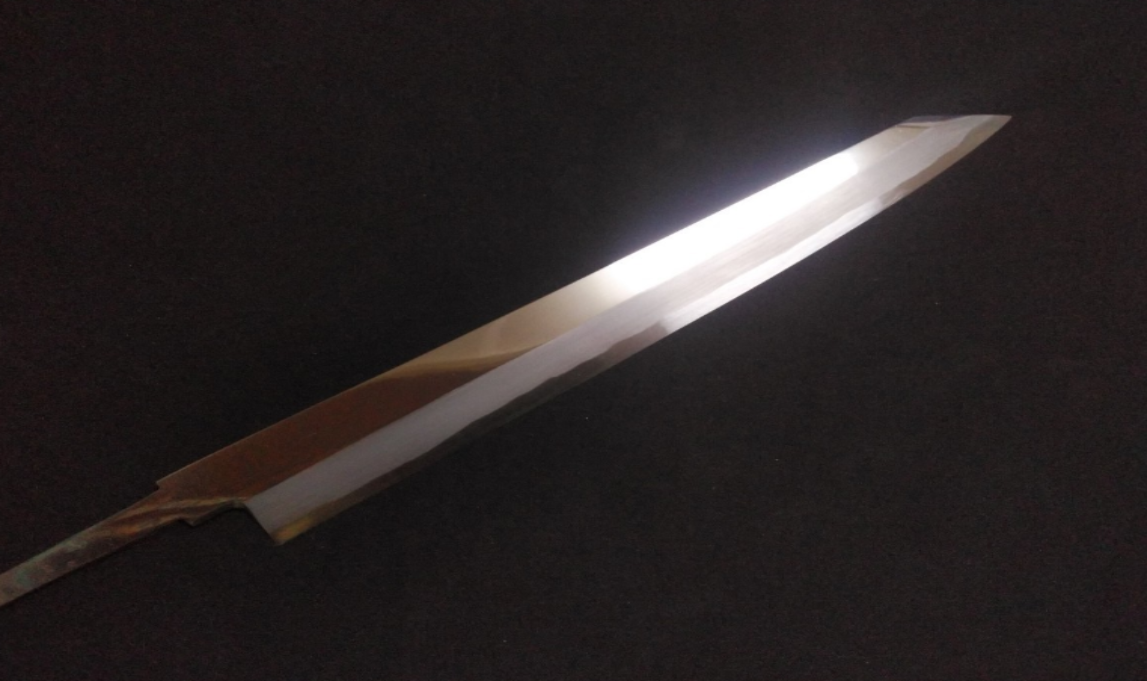
Why Many Product Photos Show Only the Blade
At KIREAJI, every knife is Made to Order.
That means your knife is completed — handle attached and final adjustments made — only after you place your order, by skilled artisans in Sakai, Japan.

Global Delivery from Sakai
Across the world, discerning customers seekgenuine Japanese knives crafted in Sakai.
At KIREAJI, we work alongside the master artisans of Sakai to fulfill that desire — shipping authentic Japanese knives straight from Sakai to kitchens around the globe.
Yanagiba (Kiritsuke)
-
-
When choosing a traditional Japanese sashimi knife, the Yanagiba and its notable variation, the Kiritsuke, are among the most widely used. Each offers unique features tailored to different slicing techniques and user preferences. Understanding these distinctions is key to selecting a knife that suits your culinary goals.
-
Yanagiba
-

TheYanagibais the most common type of sashimi knife, known for its ease of use. The name comes from its blade shape, which resembles theleaves of a willoworiris leaf. The defining feature of the Yanagiba is the smooth curve from the heel to the tip, which makes it ideal forpull cuts, allowing for clean, beautiful slices of sashimi. Additionally, it iseasy to sharpen, making it a favorite among both beginners and professionals.
-
Yanagiba (Kiritsuke)
-

The Kiritsuke features a distinctive angled tip, giving it a sharp, aggressive appearance. Compared to the Yanagiba, the Kiritsuke has a thicker blade and heavier weight. This added thickness increases resistance when cutting through ingredients, which can make it more challenging to handle. However, its straight blade makes it well-suited for specific types of cuts. Maintaining the sharpness of its tip requires special sharpening techniques, as the blade’s shape needs careful preservation.
-
Price Differences and Selection
Compared to the Yanagiba, the Kiritsuke is generally more expensive, even when the blade length is the same. This is because it requiresa larger piece of steel to be shaped downin order to achieve its distinctive design, whichincreases material costs. When selecting a knife, it's important toconsider your specific needs and budget carefullyto choose the most suitable one.
What Is the Difference Between Traditional Yanagiba and Yanagiba (Kiritsuke)?
-
— The Unique Charms and Characteristics of Two Classic Japanese Sashimi Knives
The art of slicing sashimi in Japanese cuisine is not merely a cooking technique; it embodies delicate aesthetics and the skilled craftsmanship of the chef. Supporting this refined moment is the Yanagiba knife.
Both the traditional Yanagiba and the evolved Yanagiba (Kiritsuke) are specialized Japanese knives for sashimi, but they differ clearly in the shape of their tips and their resulting usability and handling.Understanding these differences can elevate not only the quality of your dishes but also your entire cooking experience.
-
Characteristics of Traditional Yanagiba
The traditional Yanagiba is designed specifically to make beautiful “hiki-giri” (pull cuts) for sashimi.
-

Tip Shape
- Slim and pointed, resembling an iris leaf
- The blade edge often curves gently, allowing for smooth slicing motion
-
Usability and Handling
- Specialized for hiki-giri: The long, slender blade and sharp tip excel at slicing fish flesh in one smooth pull, preserving the texture without crushing the fibers
- Ideal for delicate work: Perfect for thin slicing and sashimi presentation
- Great for everyday tasks: Highly versatile for basic uses like skinning fish
- Elegant movement: Its flowing and graceful design expresses traditional Japanese aesthetics
-
Characteristics of Yanagiba (Kiritsuke)
The Yanagiba (Kiritsuke) is an evolution of the traditional Yanagiba, designed to offer greater versatility and stability.
-

Tip Shape
- Features a “kiritsuke” style tip—a sharply angled, diagonally cut point
- The tip has more width and thickness, often described as diamond or triangular shaped
-
Usability and Handling
- Highly versatile: The tip’s “waist” adds stability, making it useful beyond sashimi slicing
- Excellent for decorative cuts: Sharp tip is ideal for intricate carvings and detailed cuts
- Good for chopping herbs: The curve near the tip is closer to a straight edge, suitable for chopping scallions and other ingredients
- Can handle light bone cutting: While not as heavy as a deba knife, it can manage some light work on bones
- Modern, sharp look: Its angular, sleek design makes it popular for presentation, especially in front-of-house cooking
-
Which One Suits You Best?
Pair text with an image to focus on your chosen product, collection, or blog post. Add details on availability, style, or even provide a review.
-
Traditional Yanagiba is recommended for those who:
- Value traditional Japanese culinary technique and form
- Want to bring out the delicate texture of sashimi with smooth hiki-giri slicing
- Enjoy the flowing, elegant motion of classic knife work
-
Yanagiba (Kiritsuke) is ideal for those who:
- Want a single knife to handle multiple purposes
- Need a blade suitable for decorative cutting and chopping herbs
- Feel comfortable with sharp, angular tips and appreciate a modern, straight-edged design, similar to Western knives
-
A Knife Is More Than Just a Tool — It Reflects the Soul of Your Cooking
Both the traditional Yanagiba and Yanagiba (Kiritsuke) carry deep history and meaning, enhancing the skills and sensitivity of the user. Even the slightest difference in blade tip can change the beauty of the cut, the feel in your hand, and the taste of the dish.
The passion in every slice begins with choosing the right knife.
Find the one that best matches your cooking style and aesthetic sense.
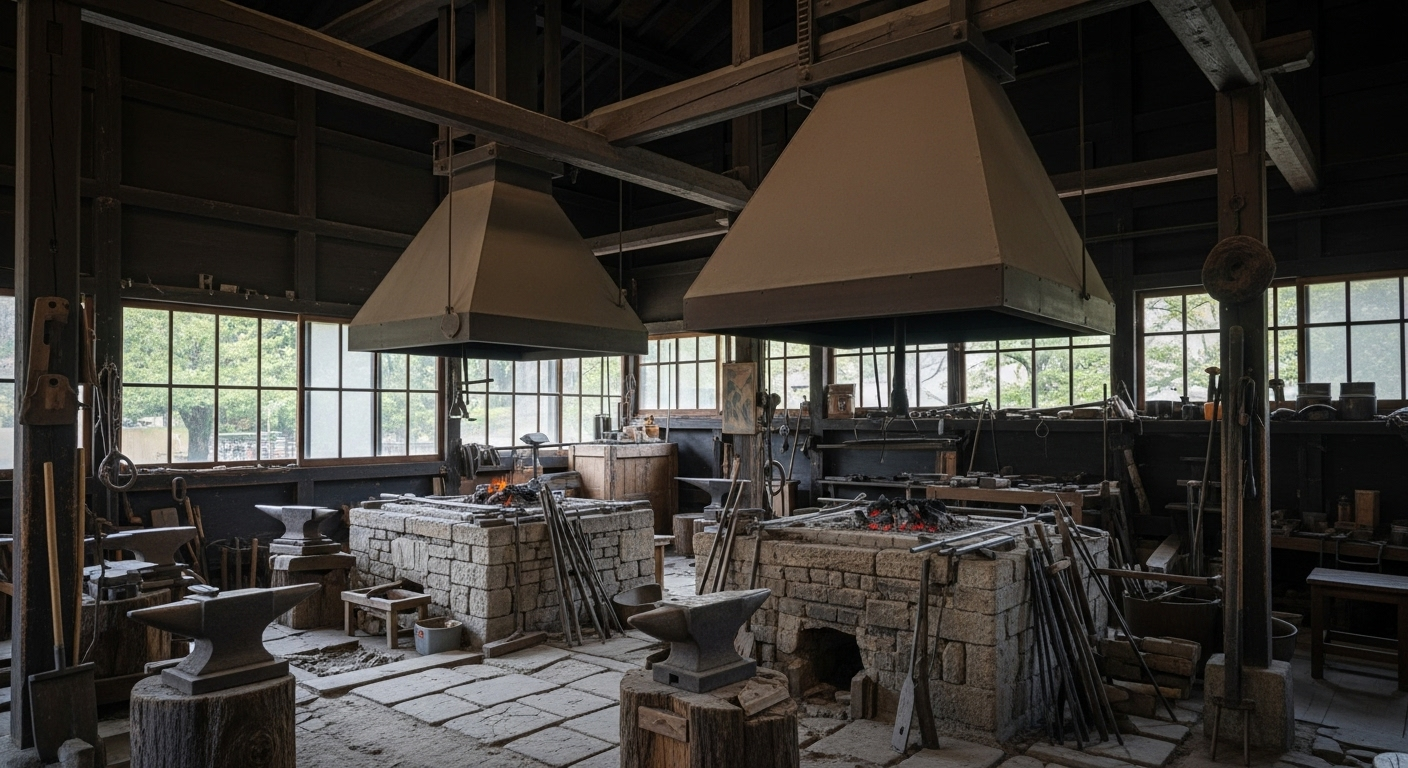
FAQ About Yanagiba(Kiritsuke)

01. What is a Yanagiba (Kiritsuke)?
The Yanagiba (Kiritsuke) is a modern variation of the traditional Japanese Yanagiba, characterized by its angled Kiritsuke-style tip. While maintaining excellent slicing ability for sashimi, it also offers enhanced versatility for decorative cuts and detailed knife work.
02. How is it different from a traditional Yanagiba?
ー Tip shape: Traditional Yanagiba has a slender, slightly curved pointed tip, whereas the Kiritsuke features an angled, more robust rhomboid or chisel-shaped tip.
ー Stability and control: The Kiritsuke’s tip design provides greater stability, enabling fine garnishing and light chopping.
ー Versatility: Suitable for a broader range of tasks beyond sashimi slicing.
03. Can I use a Yanagiba (Kiritsuke) to cut meat?
ー Primarily designed for slicing raw fish.
ー Can be used for thin slices of soft meat.
ー Not recommended for tougher cuts, sinewy textures, or bone-in meat.
ー For heavier meat preparation, a Western-style chef’s knife or a Japanese deba knife is more appropriate.
04. How is it different from a Yanagiba (Sakimaru)?
ー Yanagiba (Sakimaru): Rounded, upward-curved tip favored in kaiseki and ceremonial cuisine for its elegant look.
ー Yanagiba (Kiritsuke): Sharper, more angular tip, popular in open kitchens and chef’s counters for its combination of visual appeal and practicality.

Japan’s Sashimi Culture Was Born from a Razor-Sharp Knife
Sashimi is more than just raw fish—it’s a tradition, an art, and a precise culinary practice that could only have been born in Japan. At the heart of this refined cuisine lies a tool that made it all possible: the Japanese knife. In this article, we explore how the evolution of ultra-sharp knives shaped the rise of sashimi, and why the blade’s ability to cut with surgical precision is not just a detail—it’s the foundation of Japan’s raw fish culture.
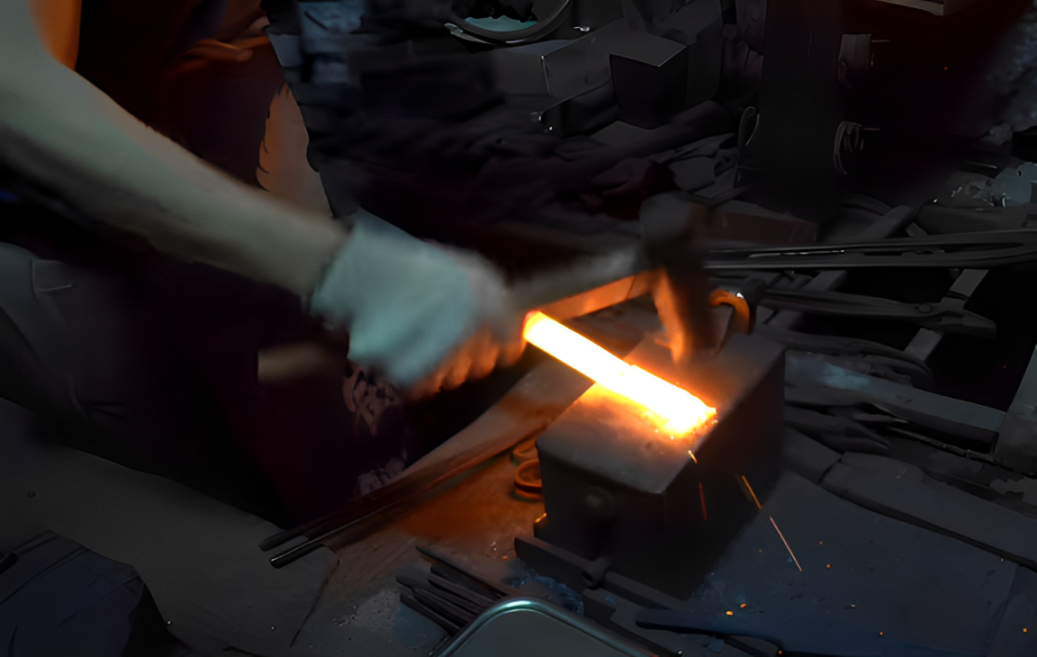
The Origin of Craftsmanship
-
The Timeless Craft of Yanagiba Knives—A Chef’s Trusted Partner
A Yanagiba knife is more than just a tool for a chef; it’s a reflection of their skill, individuality, and dedication. Choosing the right shape isn’t simply a matter of personal preference—it’s deeply influenced by years of practice and the traditions passed down from their mentors.
-
The kiritsuke shape, in particular, enhances precision when filleting fish or preparing sashimi, showcasing the unique style of each chef. This design isn’t just about aesthetics—it’s about efficiency and functionality in every cut.
-
We craft each Yanagiba knife with meticulous attention, blending time-honored techniques with modern demands. Every detail is carefully considered to ensure the knife performs at its best in the hands of a skilled chef.
-
Through our Yanagiba knives, we strive to empower chefs to fully express their artistry and passion. Supporting their journey with tools they can rely on is the mission we hold close as craftsmen.





